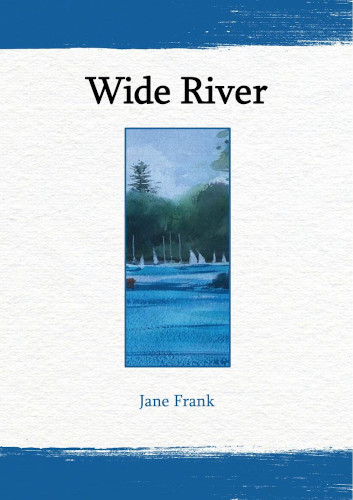Published in the Rochford Street Review.
In every poetry collection, there is one aspect, one overwhelming impression, that we are left with which later comes to define it for us. In Frank’s Wide River, it is the poet’s quiet insistence on reawakening us to the essential wonder of our world that stays with us. In the course of twenty-seven poems, the possibility of any expected or staid response is deliberately peeled away; if familiarity breeds blindness, Frank’s overwhelming achievement is surely to restore us to a gloriously sensitised vision of things:
… In
NASA’s photo, the Earth’s eyes weep fire,
red petechiae overlaid like snake bites …But here before me this morning,
life is as simple as a tiny fern forest withits ideal miniature microclimate.
– ‘Terrarium Workshop’.
How this is achieved is more complex than may first appear. Frank writes in free verse, in a style that is lyrical, lucid and deceptively approachable. There is a seamless quality underpinning her poetry, making the reading of it an effortless and thoroughly enjoyable experience. Early on, she reminds us that it’s easier “to follow the natural course of things” (‘The Mary’). The observation is slipped in gently, almost unobtrusively, but grows in resonance as the chapbook unfolds. Like ‘The Mary’– the river after which the book is named – the poems carry us forward through the natural course of a life deeply felt and keenly observed, charting a path as meandering as that of the river itself.
From the inner-western Brisbane dwelling where the poet finds herself “camping in a deep crease of the city” (‘Mort Street, Paddington’), we are transported to a room’s interior with the “relief of a wall of books slouching”, and the “cacophony of half conceived / thoughts” (‘Everything Will Be Okay’). Similarly, a “pastiche of book faces” comes to symbolise “lost time excavated, reawakened from the / detritus of the past” (‘We are all Wildflowers Pressed between Transparencies’).
But it is the wild beauty of rural Queensland, where Frank grew up, which provides the indelible inspiration in her work, whether in scenes of wildlife such as a “content mob of kangaroos” (‘Portraits’) or in the embracing of a wider, quintessentially Australian landscape punctuated by, for instance, “a sketched-in hint / of gums against a shepherd’s sky” (‘Taken Back’).
Environmental concern is an increasing feature of much contemporary poetry, and Frank’s is no exception. And so, we read the ironic musings of the last male White Rhinoceros on it “being too late for love” (‘Recollections of the Last Male Northern White Rhinoceros’), or how one natural blessing reveals another shame:
… the sweet relief
of rain that kills
tens of thousands of rotting fish– ‘Wolf Moon’
This is eco-poetry of the most delicate kind, felt again in this succinct yet electrifying portrait of a modern oil spill, arguably the standout poem in the book:
Vivid as a kelp garden teeming with life in the
Bight where they want to drill: cyan, cadmium,
The shrill yellow of unblackened coral, textureSmooth as honeyed trumpet music. A mastaba
Of greed, a historical set piece, a burning afterlife– ‘Afterlife’.
Any discussion of Frank’s work would be incomplete without paying tribute to a highly refined ekphrastic element. It is, as she admits herself in the Foreward to the collection, “poetry’s image-making power” that attracts her to the genre, and she brings to her work a heightened sense of the texture of language, the colour of words. Her pages are, one might say, carefully primed, and her words skilfully applied and layered:
… I am counting the blades
now, the many strokes it took andlooking for evidence of where
the brush was loaded up, splayed
so the sky sieved its heavy lilacmedley in a swathe of promise.
– ‘Rearranging the Paintings after they Return from your Retrospective’
Other works are permeated by a delightfully wry sense of humour. Read Frank, and you may never sit down to dinner in quite the same way again:
This evening feels like a date with Braque—
lamplight monochrome, bottle and plate
tessellated, crumpled napkin broken into glass
shards, tablecloth shapes interlocking,overlapping. Until I ate them, the chicken
and broccoli were perfectly spaced on the plate.– ‘Still Life with Captions’
Yet Frank’s poetry does more than draw parallels between art and life; in its understated poise and nuanced juxtapositions it alerts us to an alternative way of responding to reality to give voice to feelings that often elude common parlance. We begin to sense the presence of “another language” (‘Hollow’), one with the power to speculate whether:
one day mathematicians might be
Able to establish how much love
is contained in vivid colour …– ‘Fractals’.
Although Frank is not overtly metapoetic, reading her poems is a full immersion into the language of poetry, the effects of which stay with us long after we have finished the physical act of reading them – surely a hallmark of the most accomplished poetry.

